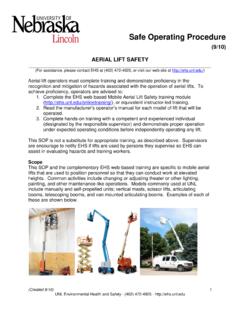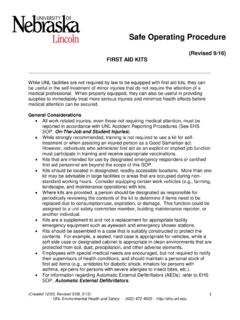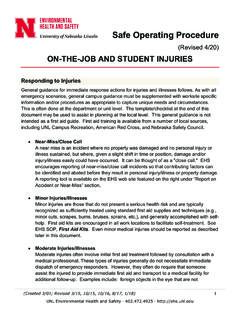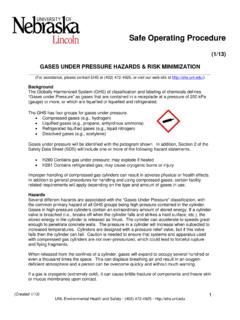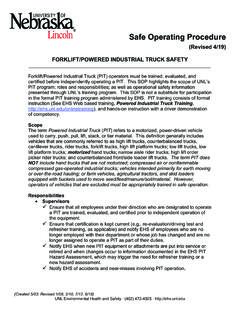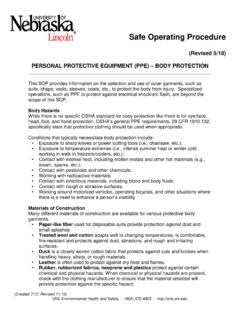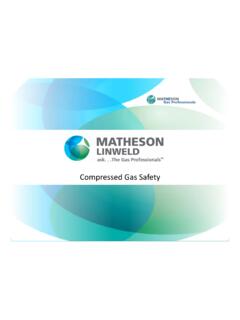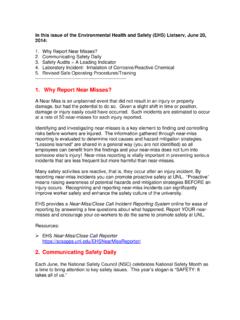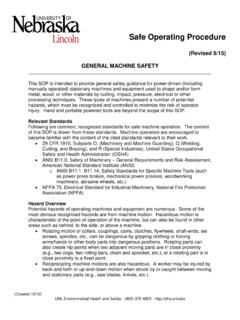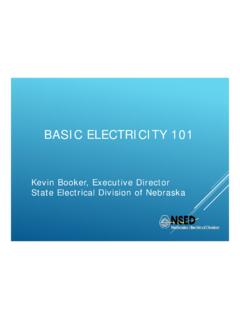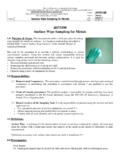Transcription of Chemical Safety
1 11 Chemical SafetyChemical SafetyWhat you donWhat you don t know can hurt yout know can hurt youMichael J. RussellDirectorDept. of Environment, Health & SafetyUniversity of Kansas Lawrence Campus22 Introduction 1 Introduction 1 Chemicals are all around are all around us. In the food we the food we eat. The clothes we clothes we wear. The vehicles we vehicles we drive. In the products we use the products we use can help us live better lives, but we must Chemicals can help us live better lives, but we must understand and respect their potential hazards. understand and respect their potential hazards. Otherwise, they can harm , they can harm 2 Introduction 2 More than 30 million workers are potentially exposed to More than 30 million workers are potentially exposed to one or more Chemical or more Chemical are an estimated 650,000 existing hazardous There are an estimated 650,000 existing hazardous Chemical products, and hundreds of new ones are being Chemical products, and hundreds of new ones are being introduced can pose a potential serious problem for exposed This can pose a potential serious problem for exposed workers and their and their you at risk because you work with chemicals?
2 Are you at risk because you work with chemicals?The answer is: YesThe answer is: YesHow much risk? How much risk? It Depends! It Depends! (Sorry, but it is not a simple answer.)(Sorry, but it is not a simple answer.)This program will attempt to provide some basic information This program will attempt to provide some basic information to address your concerns about working with hazardous to address your concerns about working with hazardous chemicals. Hopefully, it will help you better understand chemicals. Hopefully, it will help you better understand them so you can use them safely and limit your so you can use them safely and limit your 3 Introduction 355 Chemical SafetyChemical SafetyChemical- any element, Chemical compound, or mixture of elements and/or being secure from undergoing or causing hurt, injury, or An item or condition which poses potential risk to Safety or Safety - being secure from undergoing or causing hurt, injury, or loss when working with elements, Chemical compounds, or mixtures of elements and/or Hazards- elements, Chemical compounds.
3 Or mixtures of elements and/or compounds which poses potential risk to Safety or Hazard Communication StandardOSHA Hazard Communication Standard29 CFR 29 CFR --Hazardous Chemicals in the Hazardous Chemicals in the Workplace Workplace -- Employee Right to KnowEmployee Right to Know OSHA Chemical Hygiene or Lab StandardOSHA Chemical Hygiene or Lab Standard29 CFR 29 CFR --Occupational exposure to hazardous Occupational exposure to hazardous chemicals in laboratorieschemicals in laboratoriesAlso 30 OSHA Substance Specific StandardsAlso 30 OSHA Substance Specific StandardsAlso OSHA Air Contaminants (500+)Also OSHA Air Contaminants (500+)88 Hazardous ChemicalHazardous Chemical Simple Definition-- elements, Chemical compounds, or mixtures of elements and/or compounds which poses potential risk to Safety or Definition- means any Chemical which presents a physical hazard or a health ChemicalHazardous ChemicalWhat is a physical hazard?
4 What is a physical hazard? Physical Hazard means a Chemical for which means a Chemical for which there is scientifically valid evidence that it is a:there is scientifically valid evidence that it is a:Combustible liquidCombustible liquidCompressed GasCompressed GasExplosiveExplosiveFlammableFlammableO rganic peroxideOrganic peroxideOxidizerOxidizerPyrophoricPyroph oricunstable (reactive) or unstable (reactive) or waterwater--reactive. reactive. 1010 Hazardous ChemicalHazardous ChemicalPhysical Hazard CategoriesPhysical Hazard CategoriesFire HazardsFlammable gas Flammable gas Flammable aerosolFlammable aerosolFlammable solid Flammable solid Flammable liquid Flammable liquid Combustible liquid Combustible liquid Oxidizer Oxidizer PyrophoricPyrophoric1111 Hazardous ChemicalHazardous ChemicalPhysical Hazard CategoriesPhysical Hazard CategoriesExplosion HazardsCompressed gasCompressed gasExplosiveExplosiveReactive HazardsOrganic peroxideOrganic peroxideUnstable (reactive)Unstable (reactive)
5 WaterWater--reactivereactive1212 Hazardous ChemicalHazardous ChemicalWhat is a health hazard?What is a health hazard? Health Hazard means a Chemical for which there is means a Chemical for which there is statistically significant evidence based on at least one statistically significant evidence based on at least one study conducted in accordance with established study conducted in accordance with established scientific principles that acute or chronic health effects scientific principles that acute or chronic health effects may occur in exposed employees. Includes: may occur in exposed employees. Includes: CarcinogensCarcinogensToxic or highly toxic agents Reproductive toxins Toxic or highly toxic agents Reproductive toxins Irritants Irritants Corrosives SensitizersCorrosives SensitizersHepatotoxins NephrotoxinsHepatotoxins NephrotoxinsNeurotoxins Neurotoxins Hematopoietic system agentsHematopoietic system agentsAgents which damage the lungs, skin, eyes, or mucous membranAgents which damage the lungs, skin, eyes, or mucous membranes.
6 Es. 1313 Hazardous ChemicalHazardous ChemicalHealth Hazard CategoriesHealth Hazard CategoriesSystemic EffectsCarcinogenCarcinogenToxic agentToxic agentHighly toxic agentHighly toxic agentCorrosiveCorrosiveIrritantIrritantS ensitizerSensitizer1414 Hazardous ChemicalHazardous ChemicalHealth Hazard CategoriesHealth Hazard CategoriesTarget Organ EffectsHepatotoxinHepatotoxin--liverlive rNephrotoxinNephrotoxin--kidneyskidneysN eurotoxin Neurotoxin nervous systemnervous systemBlood/hematopoietic toxin Blood/hematopoietic toxin hemoglobin/oxygenhemoglobin/oxygenRespir atory toxin Respiratory toxin pulmonary (lungs)pulmonary (lungs)
7 Reproductive toxin Reproductive toxin organs, chromosomes, fetusorgans, chromosomes, fetusCutaneousCutaneoushazard hazard dermal layer (skin)dermal layer (skin)Eye hazard Eye hazard eye or visualeye or visualcapacitycapacity1515 Hazardous ChemicalHazardous ChemicalHealth Hazard CategoriesHealth Hazard CategoriesOther Health EffectsCardiovascular toxicityCardiovascular toxicityImmunotoxicityImmunotoxicityConn ective tissue effectsConnective tissue effectsSensory organ toxicity (sight, hearing, taste)Sensory organ toxicity (sight, hearing, taste)Gastrointestinal toxicityGastrointestinal toxicitySkeletal/muscular effectsSkeletal/muscular effectsEndocrine system toxicityEndocrine system toxicity1616 Hazard Information 1 Hazard Information 1 How can you tell if the Chemical you are working How can you tell if the Chemical you are working with is hazardous?
8 With is hazardous? Perform a Hazard Determination Review the Container Label Review the Material Safety Data Sheet Contact EHS Determination 1 Hazard Determination 1 Hazard DeterminationHazard DeterminationChemical manufacturers and importers are required to evaluate chemicals they produce or import to determine if they are includes assessment for both physical and health Labeling 1 Container Labeling 1 The Chemical manufacturer, importer, or distributor is required to ensure that each container of hazardous Chemical leaving their workplace is labeled, tagged or marked with the following information: Identity of the hazardous Chemical (s); Appropriate hazard warnings; and Name and address of the responsible party (manufacturer, importer, other).
9 1919 Container Labeling 2 Container Labeling 2In the workplace or lab, each container of hazardous chemicals must be labeled, tagged or marked with the following information: Identity of the hazardous Chemical (s) contained therein; and, Appropriate hazard warnings, 2020 Container Labeling 3 Container Labeling 3If it is in its original container as provided from the manufacturer, then maintain the original you dispense it into another container, then make sure it is immediately, appropriately labeled with: Identity of the hazardous Chemical (s) contained therein; and, Appropriate hazard warnings,2121 MSDS Information 1 MSDS Information 1 What is an MSDS?
10 What is an MSDS?"Material Safety data sheet (MSDS)" means written or printed material concerning a hazardous Chemical which is prepared in accordance with the OSHA Hazard Communication Standard {29 CFR (g)}.2222 MSDS Information 2 MSDS Information 2 Chemical manufacturers and importers shall obtain or develop a material Safety data sheet for each hazardous Chemical they produce or import. Employers shall have a material Safety data sheet in the workplace for each hazardous Chemical which they shall be readily accessible during each work shift to employees when they are in their work area(s). (Electronic access, microfiche, and other alternatives to maintaining paper copies of the material Safety data sheets are permitted as long as no barriers to immediate employee access in each workplace are created by such options.)
